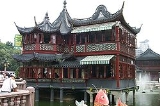
Chinese tea culture
Encyclopedia
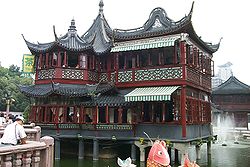
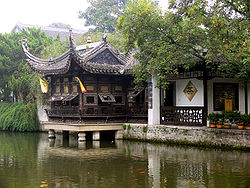
Tea
Tea is an aromatic beverage prepared by adding cured leaves of the Camellia sinensis plant to hot water. The term also refers to the plant itself. After water, tea is the most widely consumed beverage in the world...
, the equipment used to make tea and the occasions in which tea is consumed in China. The terms chayi "Art of Tea 茶藝" and "Tea Ceremony
Tea ceremony
A tea ceremony is a ritualised form of making tea. The term generally refers to either chayi Chinese tea ceremony, chado Japanese tea ceremony, tarye Korean tea ceremony. The Japanese tea ceremony is more well known, and was influenced by the Chinese tea ceremony during ancient and medieval times....
" have been used, but the term "Tea Culture茶文化" includes more than just the ceremony. Also "culture" is easier to translate into English from the Chinese term "art 藝".
Tea culture in China differs from that of Europe
Europe
Europe is, by convention, one of the world's seven continents. Comprising the westernmost peninsula of Eurasia, Europe is generally 'divided' from Asia to its east by the watershed divides of the Ural and Caucasus Mountains, the Ural River, the Caspian and Black Seas, and the waterways connecting...
, Britain
United Kingdom
The United Kingdom of Great Britain and Northern IrelandIn the United Kingdom and Dependencies, other languages have been officially recognised as legitimate autochthonous languages under the European Charter for Regional or Minority Languages...
or Japan
Japan
Japan is an island nation in East Asia. Located in the Pacific Ocean, it lies to the east of the Sea of Japan, China, North Korea, South Korea and Russia, stretching from the Sea of Okhotsk in the north to the East China Sea and Taiwan in the south...
in such things as preparation methods, tasting methods and the occasions for which it is consumed. Even now, in both casual and formal Chinese occasions, tea is consumed regularly. In addition to being a drink, Chinese tea is used in traditional Chinese medicine
Traditional Chinese medicine
Traditional Chinese Medicine refers to a broad range of medicine practices sharing common theoretical concepts which have been developed in China and are based on a tradition of more than 2,000 years, including various forms of herbal medicine, acupuncture, massage , exercise , and dietary therapy...
and in Chinese cuisine
Chinese cuisine
Chinese cuisine is any of several styles originating in the regions of China, some of which have become highly popular in other parts of the world – from Asia to the Americas, Australia, Western Europe and Southern Africa...
.
Etymology
For contemporary Chinese, the word "茶" (pinyin: chá) has come to commonly denote the drink that is derived from Camellia sinensis, the tea plant (茶樹/茶树, pinyin: cháshù). Prior to the 8th century BC, the tea was known collectively under the term "荼" (pinyin: tú) along with a great number of other bitter plants. The great similarity of the two characters are notable with the exception of an additional horizontal stroke in 荼. The character is made up of the "艸" (pinyin: cǎo) radicalRadical (Chinese character)
A Chinese radical is a component of a Chinese character. The term may variously refer to the original semantic element of a character, or to any semantic element, or, loosely, to any element whatever its origin or purpose...
in its reduced form of "艹" and the word "余" which gives the phonetic cue. The plant was later more distinctly identified and was called "檟苦荼" (pinyin: jiǎkǔtú, literally "'evergreen shrub' of bitter 'bitter plant'"), or in simplified forms "苦荼" (pinyin: kǔtú) or "荈" (pinyin: chuǎn).
The word "茗" (pinyin: míng), which was possibly derived from the Burmese
Burmese language
The Burmese language is the official language of Burma. Although the constitution officially recognizes it as the Myanmar language, most English speakers continue to refer to the language as Burmese. Burmese is the native language of the Bamar and related sub-ethnic groups of the Bamar, as well as...
word, was later used to indicate tea where its popularity spread and became more common in Ancient China. This word is still used in modern tea communities in Taiwan
Republic of China
The Republic of China , commonly known as Taiwan , is a unitary sovereign state located in East Asia. Originally based in mainland China, the Republic of China currently governs the island of Taiwan , which forms over 99% of its current territory, as well as Penghu, Kinmen, Matsu and other minor...
and the People's Republic of China
People's Republic of China
China , officially the People's Republic of China , is the most populous country in the world, with over 1.3 billion citizens. Located in East Asia, the country covers approximately 9.6 million square kilometres...
to denote tea. By the end of the 8th century BC, the character "荼" was finally simplified to "茶". Lù Yǔ
Lu Yu
Lu Yu is respected as the Sage of Tea for his contribution to Chinese tea culture. He is best known for his monumental book The Classic of Tea , the first definitive work on cultivating, making and drinking tea.-Biography:...
(陸羽/陆羽, 733-804) of the Tang Dynasty
Tang Dynasty
The Tang Dynasty was an imperial dynasty of China preceded by the Sui Dynasty and followed by the Five Dynasties and Ten Kingdoms Period. It was founded by the Li family, who seized power during the decline and collapse of the Sui Empire...
, wrote in his crowning work, The Tea Classic or Chájīng (茶經/茶经), on the origins of the character for tea as well as the numerous words used to denote tea. In the first chapter of Chájīng, "The origins" (卷上, 一之源) he wrote:
which means: "Its character: may come from herb/grass (茶 chá from 文字音義 Wénzì yīnyì in 736 AD), or from tree/wood (梌 tú from 本草經 Běncǎojīng, an ancient medical text), or the combination of the two (荼 tú from the 爾雅 Ěryǎ, atreatise on lexicography from the Han dynasty
Han Dynasty
The Han Dynasty was the second imperial dynasty of China, preceded by the Qin Dynasty and succeeded by the Three Kingdoms . It was founded by the rebel leader Liu Bang, known posthumously as Emperor Gaozu of Han. It was briefly interrupted by the Xin Dynasty of the former regent Wang Mang...
)"
which means: Its names: first it is called 茶 chá, then 檟 jiǎ, thirdly 蔎 shè, fourthly 茗 míng, fifthly 荈 chuǎn.
Where:
- 檟 jiǎ: according to the author Yang Xiong of Han dynasty, the term was used by Zhoūgōng (周公), the duke ofDuke of ZhouThe Duke of Zhou played a major role in consolidating the newly-founded Zhou Dynasty . He was the brother of King Wu of Zhou, the first king of the ancient Chinese Zhou Dynasty...
Zhou dynastyZhou DynastyThe Zhou Dynasty was a Chinese dynasty that followed the Shang Dynasty and preceded the Qin Dynasty. Although the Zhou Dynasty lasted longer than any other dynasty in Chinese history, the actual political and military control of China by the Ji family lasted only until 771 BC, a period known as...
to indicate the 苦荼 (kǔtú) - 蔎 shè: the term by which natives of present day SìchuānSichuan' , known formerly in the West by its postal map spellings of Szechwan or Szechuan is a province in Southwest China with its capital in Chengdu...
used to indicated 荼 (tú) - 茶,蔎,茗,荈 chá, shè, míng, chuǎn: in legends, Guōhóngnóng (郭弘農), specified that first tea harvest is known as chá, followed by míng, then shè, and finally chuǎn
Tea drinking customs
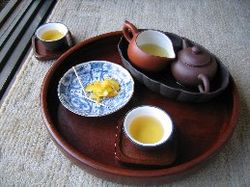

- as a sign of respect
- In Chinese society, the younger generation always shows their respect to the older generation by offering a cup of tea. Inviting their elders to go to restaurants and having some tea is a traditional activity on holidays. In the past, people of lower rank served tea to higher ranking people. Today, as Chinese society becomes more liberal, sometimes parents may pour a cup of tea for their children, or a boss may even pour tea for subordinates at restaurants. However, the lower ranking person should not expect the higher ranking person to serve him or her tea in formal occasions.
- For a family gathering
- When sons and daughters leave home because of work or get married, they may have few times to visit their parents, and parents may seldom meet their grandchildren as well. Therefore, going to restaurants and drinking tea becomes an important activity for family gatherings. Every Sunday, Chinese restaurants are crowded, especially when people celebrate festivals. This phenomenon reflects Chinese family values.
- To apologize
- In Chinese culture, people make serious apologies to others by pouring tea for them. For example, children serving tea to their parents is a sign of regret and submission.
- To express thanks to your elders on one's wedding day
- In the traditional Chinese marriageChinese marriageTraditional Chinese marriage is a ceremonial ritual within Chinese societies that involve a marriage established by pre-arrangement between families. Within Chinese culture, romantic love was allowed, and monogamy was the norm for most ordinary citizens....
ceremonyCeremonyA ceremony is an event of ritual significance, performed on a special occasion. The word may be of Etruscan origin.-Ceremonial occasions:A ceremony may mark a rite of passage in a human life, marking the significance of, for example:* birth...
, both the bride and groom kneel in front of their parents and serve them tea. That is the most devout way to express their gratitude. In front of their parents, it is a practice for the married couple to say, "Thank you for bringing us up. Now we are getting married. We owe it all to you." The parents will usually drink a small portion of the tea and then give them a red envelopeRed envelopeIn Chinese and other Asian societies, a red envelope or red packet is a monetary gift which is given during holidays or special occasions.-Usage:Red envelopes are mainly presented at social and family gatherings such as...
, which symbolizes good luck. Another variant is that the bride serve tea to the groom's parents, symbolizing that she is to become a part of the latter's family.- To connect large families on wedding days
- The tea ceremony during a wedding also serves as a means for both parties to meet with each other. As Chinese families can be rather extended, and there may be one or two hundred people, it is entirely possible during a courtship to not have been introduced to someone. This was particularly true in older generations where the patriarch may have had more than one wife and not all family members were always on good terms. As such, during the tea ceremony, the couple would serve tea to all family members and call them by their official title. Drinking the tea symbolized acceptance into the family, while refusing to drink symbolized opposition to the wedding and was quite unheard of since it would result in a loss of "face". Older generations would give a red envelopeRed envelopeIn Chinese and other Asian societies, a red envelope or red packet is a monetary gift which is given during holidays or special occasions.-Usage:Red envelopes are mainly presented at social and family gatherings such as...
to the matrimonial couple while the couple would be expected to give red envelopes to the unmarried younger ones.- Folding the napkin in tea ceremonies is a traditional action and is done to keep away bad QiQiIn traditional Chinese culture, qì is an active principle forming part of any living thing. Qi is frequently translated as life energy, lifeforce, or energy flow. Qi is the central underlying principle in traditional Chinese medicine and martial arts...
energy in ChinaChinaChinese civilization may refer to:* China for more general discussion of the country.* Chinese culture* Greater China, the transnational community of ethnic Chinese.* History of China* Sinosphere, the area historically affected by Chinese culture...
as tea (茶) was regarded as one of the seven daily necessities. The others being firewoodFirewoodFirewood is any wood-like material that is gathered and used for fuel. Generally, firewood is not highly processed and is in some sort of recognizable log or branch form....
, riceRiceRice is the seed of the monocot plants Oryza sativa or Oryza glaberrima . As a cereal grain, it is the most important staple food for a large part of the world's human population, especially in East Asia, Southeast Asia, South Asia, the Middle East, and the West Indies...
, oilCooking oilCooking oil is purified fat of plant origin, which is usually liquid at room temperature ....
, saltSaltIn chemistry, salts are ionic compounds that result from the neutralization reaction of an acid and a base. They are composed of cations and anions so that the product is electrically neutral...
, soy sauceSoy sauceSoy sauce is a condiment produced by fermenting soybeans with Aspergillus oryzae or Aspergillus sojae molds, along with water and salt...
, and vinegarVinegarVinegar is a liquid substance consisting mainly of acetic acid and water, the acetic acid being produced through the fermentation of ethanol by acetic acid bacteria. Commercial vinegar is produced either by fast or slow fermentation processes. Slow methods generally are used with traditional...
(柴,米,油,鹽,醬,醋).
- Folding the napkin in tea ceremonies is a traditional action and is done to keep away bad Qi
Finger tapping
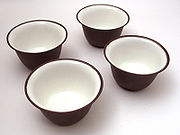
Cantonese people
The Cantonese people are Han people whose ancestral homes are in Guangdong, China. The term "Cantonese people" would then be synonymous with the Bun Dei sub-ethnic group, and is sometimes known as Gwong Fu Jan for this narrower definition...
, in other parts of China it is only acceptable if for some reason you cannot actually say thank you at that moment, for example if you are in the middle of talking with someone else at the table.
This custom is said to have originated in the Qing Dynasty
Qing Dynasty
The Qing Dynasty was the last dynasty of China, ruling from 1644 to 1912 with a brief, abortive restoration in 1917. It was preceded by the Ming Dynasty and followed by the Republic of China....
when Emperor Qian Long would travel in disguise through the empire. Servants were told not to reveal their master's identity. One day in a restaurant, the emperor, after pouring himself a cup of tea, filled a servant's cup as well. To that servant it was a huge honour to have the emperor pour him a cup of tea. Out of reflex he wanted to kneel and express his thanks. He could not kneel and kowtow
Kowtow
Kowtow is the act of deep respect shown by kneeling and bowing so low as to have one's head touching the ground. An alternative Chinese term is ketou, however the meaning is somewhat altered: kòu originally meant "knock with reverence", whereas kē has the general meaning of "touch upon ".In Han...
to the emperor since that would reveal the emperor's identity so he bent his fingers on the table to express his gratitude and respect to the emperor.
The bent fingers for knocking are technically supposed to be three to signify a bowing servant. One is the head and the other two are the arms.
It should be noted that in formal tea ceremonies nodding of the head and/or saying "thank you" is more appropriate.
Brewing Chinese tea
There are many different ways of brewing Chinese tea depending on variables like the formality of the occasion, the means of the people preparing it and the kind of tea being brewed. For example, green teaGreen tea
Green tea is made solely from the leaves of Camellia sinensis that have undergone minimal oxidation during processing. Green tea originates from China and has become associated with many cultures throughout Asia. It has recently become more widespread in the West, where black tea is traditionally...
s are more delicate than oolong
Oolong
Oolong is a traditional Chinese tea produced through a unique process including withering under the strong sun and oxidation before curling and twisting. Most oolong teas, especially those of fine quality, involve unique tea plant cultivars that are exclusively used for particular varieties...
teas or black tea
Black tea
Black tea is a variety of tea that is more oxidized than the oolong, green, and white varieties.All four varieties are made from leaves of the shrub Camellia sinensis. Black tea is generally stronger in flavor and contains more caffeine than the less oxidized teas. Two principal varieties of the...
s and should be brewed with cooler water as a result. The most informal method of brewing tea is the simple adding of leaves to a pot, and hot water. This method is commonly found in households and restaurants, as at dim sum
Dim sum
Dim sum refers to a style of Chinese food prepared as small bite-sized or individual portions of food traditionally served in small steamer baskets or on small plates...
(點心) or yum cha
Yum cha
Yum cha , also known as Ban ming , is a Chinese style morning or afternoon tea, which involves drinking Chinese tea and eating dim sum dishes...
(飲茶) in Cantonese restaurant
Cantonese restaurant
A Cantonese restaurant is a type of Chinese restaurant that originated from Southern China. This style of restaurant soon flourished in Hong Kong.-History:Some of the earliest restaurants in Colonial Hong Kong were influenced by Cantonese people...
s. Two other primary methods of brewing tea are the Chaou method and the Gongfucha method. Chaou brewing tends towards a more formal occasion and is generally used for more delicate teas, medicinal teas and tea tastings. Gongfucha brewing is a far more formal method of tea brewing (mainly for oolong or double fermented teas like Pu'erh) although even this method can be made more or less formal depending on the occasion. The first Ming Dynasty Emperor Hongwu contributed to the development of loose tea brewing by banning the production of compressed tea.
Chaou brewing
GàiwǎnGaiwan
A gaiwan is a Chinese lidded bowl used for the infusion and consumption of tea and was invented during the Ming Dynasty. It consists of a bowl, a lid, and a saucer.-History:...
also known as a cover bowl(蓋碗/盖碗; lit., "lidded bowl"), also known as 蓋杯 (Pinyin: gàibēi; lit., "lidded cup") or 焗盅 (Pinyin: júzhōng; lit., "heat suffocation vessel") depending on the region of the China. "Gaiwan" is a relatively new word. This method of 'brewing' tea was originally developed by the Chaoshan people and its original name is Chá-ōu, 茶甌 (simplified 茶瓯). There are two words for brewing. One is chōng (沖) and the other is pào (泡). For chaou brewing, the word zhōng is used rather than pào.
The chaou is a three piece teaware consisting of a lid, cup/bowl, and a saucer. Chaous are generally made of porcelain or are glazed on the inside in order to prevent a buildup of tannins. The chaou may be used on its own or with tasting cups on the side. Chaou brewing is usually employed in tea tasting
Tea tasting
Tea tasting is the process in which a trained taster determines the quality of a particular tea. Due to climatic conditions, topography, manufacturing process, and different clones of the Camellia sinensis plant , the final product may have vastly differing flavours and appearance...
situations, such as when buying tea, where neutrality in taste and ease of access to brewing leaves for viewing and sniffing is important. This method of serving is often used in informal situations, though it can also be used on more formal occasions. Chaou brewing can be used for all forms of teas though lightly oxidized teas benefit most from this brewing method.
Brewing tea using a Gaiwan
- Boil water, or heat to specified temperature for tea
- Heat the teaware with boiling water
- Add leaves to line bottom of the cup
- Rinse tea leaves and drain
- Slip water along the side while pouring into the Chaou
- Fill to ~2/3 full
- Wait for 30 seconds, Serve
Gongfu chadao/ (tea ceremony) brewing
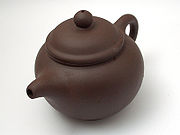
The Gōngfu Chá Dào (工/功夫茶道) also known as "工Gongfucha" or the "功Kung Fu Tea Ceremony" is a relatively famous tradition of Minnan (閩南) and Chaozhou (潮州) or Chaoshan (潮汕). It makes use of small Yixing teawares
Yixing clay
Yixing clay is a type of clay from the region near the city of Yixing in Jiangsu province, China. Its use dates back to the Song Dynasty when purple clay was first mined around Lake Taihu in China. From the 17th century on, the ware was commonly exported to Europe. The finished stoneware, which...
teapot of about 100 – 150 ml (4 or 5 fl.oz.) to enhance the aesthetics, and more importantly "round out" the taste of the tea being brewed. Yixing teapot brewing sides towards the formal, and is used for private enjoyment of the tea as well as for welcoming guests. The following steps are one popular way to brew tea in a form considered to be a kind of art. Depending on the region of China the steps may differ, as will the tools used in the making of tea (e.g. Taiwanese-style Gongfu cha which makes use of several additional instruments including tweezers and a tea strainer). This procedure is mostly applicable to Oolong teas only although some use it to make Pu'erh and other double-fermented teas.
A Gongfu Tea(Cha) method
- Boil water.
- Rinse the teapotTeapotA teapot is a vessel used for steeping tea leaves or a herbal mix in near-boiling water. Tea may be either in a tea bag or loose, in which case a tea strainer will be needed, either to hold the leaves as they steep or to catch the leaves inside the teapot when the tea is poured...
with hot water. - Fill the teapot with tea leaves up to one third of the height of the pot.
- Rinse the tea leaves by filling the pot with hot water up to half full and draining the water immediately leaving only tea leaves behind. (This step, and all subsequent steps involving pouring water, should be performed in a large bowl to catch any overflow.)
- Pour more hot water into the teapot and pour water over the teapot in the large bowl. Bubbles should not be permitted to be formed in the teapot. The infusion should not be steeped for too long: 30 seconds is an appropriate maximum.
- Pour the first infusion into small serving cups within a minute by continuously moving the teapot around over the cups. Each cup of tea is expected to have the same flavour, aroma and colour. The nature of this procedure almost mandates the use of some form of drip tray to catch further spillage.
- Pour excess tea from the first infusion, and all tea from further infusions, into a second teapot after steeping. It is possible to draw five or six good infusions from a single pot of tea, but subsequent infusions must be extended somewhat in duration to extract maximum flavour: the second infusion extended by approximately ten seconds to 40 seconds, the third extended to 45, etc.
Tea ceremonies
The Chinese tea ceremony, also called the Chinese Way of Tea, is a Chinese cultural activity involving the ceremonial preparation and presentation of tea leaf. The manner in which it is performed, or the art of its performance is shown in the tea ceremony. Taoism has also been an influence in the development of the tea ceremony. The elements of the Chinese tea ceremony is the harmony of nature and enjoying tea in an informal and formal setting. Tea ceremonies are now being revived in China's new fast-paced culture, and continuing in the long tradition of intangible Chinese art.Influence of tea on Chinese culture
Tea has had a major influence on the development of Chinese culture. Chinese traditional culture is closely connected with Chinese tea. In literature, arts, and philosophy, tea is often associated. Tea is connected closely with Taoism, Buddhism and Confucianism. Roughly, since Tang Dynasty, drinking tea is a must for self-cultivation. Chinese Chan (Japanese:Zen or philosophy is also linked with drinking tea.Tea ware
Traditionally tea drinkers were always considered to be high level or elite and highly respected by society, because drinking tea is the show of personal morality, education, principle and status. Increased enthusiasm for tea drinking led to the greater production of tea ware, and also significantly popularised Chinese porcelain culture.Teahouse
Chinese scholars have used the teahouse for places of sharing ideas. Teahouse is the by-product of Chinese tea culture but it also the historical evidence of Chinese tea history. Currently, people can also feel such a kind of humanistic atmosphere in Beijing like Lao She Teahouse and East China like Hangzhou, Suzhou, Yangzhou, Nanjing, Wuxi, Shaoxing and Shanghai and so on. It is still dynamic and vigorous.Modern culture
In modern China, virtually every dwelling—down to the simplest mud huts—has a set of tea implements for brewing a hot cup of tea. These implements are symbols of welcome for visitors or neighbors. Traditionally, a visitor to a Chinese home will be expected to sit down and drink tea while talking; the Chinese consider having such visits while standing to be uncouth. There are several types of tea. There is green tea, oolong tea, red tea, black tea, white tea, yellow tea, puerh tea and flower tea. Tea leaves are traditionally produced by constantly turning fresh leaves in a deep bowl. This process allows it to dry with its full flavor ready to be used.Below are some Chinese tea ceremonies:
- Gongfu tea ceremonyGongfu tea ceremonyThe gongfu tea ceremony or kungfu tea ceremony , is a commercialized show basing on the tea preparation approach originated probably in Fujian or Guangdong. The original term "Gongfu Cha " literally means "making tea with efforts". Sometimes '功' instead of '工' is used thus 功夫茶...
- Wu-Wo Tea CeremonyWu-Wo tea ceremonyWu-Wo Tea Ceremony 無我茶會, also known as Wu-Wo Tea Convention and Wuwo Tea Party. It is a style of Chinese tea ceremony that encourages participants to forget about knowledge, wealth, and appearance to establish a group equality without prejudice. This concept of Wu-Wo is shown in the Wu-Wo Tea...
- Tea Appreciation DayTea Appreciation DayTea Appreciation Day is held one day during the first weekend of May every year from 2005. People and organizations can gather together to make and serve tea with the attending individuals and passing strangers alike...
- Perennial Tea CeremonyPerennial tea ceremonyPerennial tea ceremony / Four Seson Tea Ceremony is a Chinese tea ceremony, created by Lin Easu , of the Ten Ren Teaism Foundation. The first two characters of the Chinese term literally mean four steps or sequences that are linked together, the latter two simply meaning "tea ceremony". With...
Tea culture education
- Schools of Chinese Tea CeremonySchools of Chinese Tea Ceremony"Schools of Chinese Tea Ceremony" refers to the various arts and culture of the Chinese Tea Ceremony. The foundation of Chinese Tea Ceremony is through the art of tea ceremony to make various types of tea and brewing methods with the goal to achieve the best cup of tea in a beautiful and graceful way...
- Lu-Yu Tea Culture InstituteLu-Yu Tea Culture InstituteLu-Yu Tea Culture Institute, previously known as Lu Yu Tea Art Center, provides education in tea arts and promotes the drinking of tea. It offers certifications in Tea Studies, such as for "Tea Master" . The institute was founded in Taipei, Taiwan, in the 1980s...
- Tenfu Tea CollegeTenfu Tea CollegeTenfu Tea College is the world's first private vocational college to specialise in the study of the tea industry. It is situated in Zhangzhou, Fujian, China, Degrees in the following disciplines are: Tea Production and Processing , Market Prospection and Marketing , Food Processing , Tea Culture ...
See also
- Tea ceremonyTea ceremonyA tea ceremony is a ritualised form of making tea. The term generally refers to either chayi Chinese tea ceremony, chado Japanese tea ceremony, tarye Korean tea ceremony. The Japanese tea ceremony is more well known, and was influenced by the Chinese tea ceremony during ancient and medieval times....
- The Classic of TeaThe Classic of TeaThe Classic of Tea or Tea Classic is the very first monograph on tea in the world, written by Chinese writer Lu Yu between 760 CE and 780 CE during the Tang Dynasty....
- Chinese teaChinese teaThe practice of drinking tea has had a long history in China, having originated there. The Chinese drink tea during many parts of the day such as during meals for good health or for simple pleasure.-History:...
- Yum chaYum chaYum cha , also known as Ban ming , is a Chinese style morning or afternoon tea, which involves drinking Chinese tea and eating dim sum dishes...
- Culture of ChinaCulture of ChinaChinese culture is one of the world's oldest and most complex. The area in which the culture is dominant covers a large geographical region in eastern Asia with customs and traditions varying greatly between towns, cities and provinces...
- Tea ClassicsTea ClassicsTea as a beverage was first consumed in China no later than the fifth century BCE. The earliest extant mention of tea in literature is in the Shih Ching or Book of Songs, written circa 550 BCE, although the ideogram used in these texts can also designate a variety of plants, such as sowthistle...
- Chinese social relationsChinese social relationsChinese social relations are social relations typified by a reciprocal social network. Often social obligations within the network are characterized in familial terms. The individual link within the social network is known by guanxi and the feeling within the link is known by the term ganqing...
- Chinese artChinese artChinese art is visual art that, whether ancient or modern, originated in or is practiced in China or by Chinese artists or performers. Early so-called "stone age art" dates back to 10,000 BC, mostly consisting of simple pottery and sculptures. This early period was followed by a series of art...
- Japanese tea ceremonyJapanese tea ceremonyThe Japanese tea ceremony, also called the Way of Tea, is a Japanese cultural activity involving the ceremonial preparation and presentation of matcha, powdered green tea. In Japanese, it is called . The manner in which it is performed, or the art of its performance, is called...
- Teaism
- Schools of Chinese Tea CeremonySchools of Chinese Tea Ceremony"Schools of Chinese Tea Ceremony" refers to the various arts and culture of the Chinese Tea Ceremony. The foundation of Chinese Tea Ceremony is through the art of tea ceremony to make various types of tea and brewing methods with the goal to achieve the best cup of tea in a beautiful and graceful way...
Tea cultures of specific traditions and regions
- Hong Kong tea cultureHong Kong tea cultureThe tea-drinking habits of Hong Kong residents derive from Chinese tea culture. After more than 150 years of British rule, however, they have changed somewhat to become unique in the world...
- Taiwanese tea cultureTaiwanese tea cultureTaiwanese tea culture, include tea arts, tea ceremony, and a very social way of enjoying tea. While the most common teas are oolongs especially Taiwanese oolongs such as Iron Goddess and Alpine Oolong; Puers, black teas and green teas are also popular. Many of the classical arts can be seen in...
- Japanese tea culture
- Korean tea cultureKorean tea ceremonyThe Korean tea ceremony or darye is a traditional form of tea ceremony practiced in Korea. Darye literally refers to "etiquette for tea" or "day tea rite" and has been kept among Korean people for a few thousand years...
- Assamese tea culture
- British tea cultureBritish tea cultureSince the 18th century the British have been the largest per capita tea consumers in the world, with each person consuming on average 2.5 kg per year. The popularity of tea occasioned the furtive export of slips to tea plants from China to British India and its commercial culture there,...
External links
- Tenfu Tea College
- Lu-Yu Tea Culture Institute
- A bilingual website that introduces Chinese Tea culture and teapots
- A bilingual website with ceremony/brewing guides and tea history
- Traditional Chinese Tea Ceremony
- Basic Facts of Tea
- An Offering of Tea during a Chinese Wedding
- commented pictures on how to brew tea

